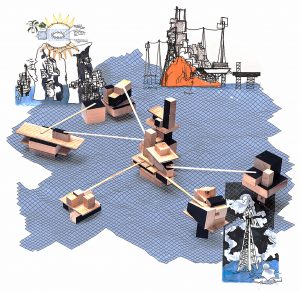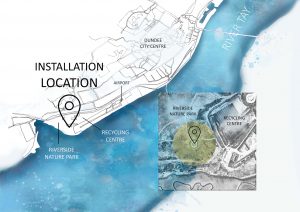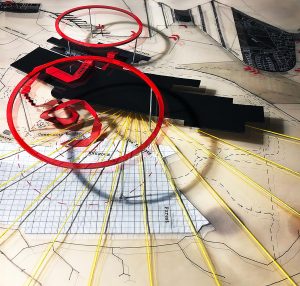DJCAD DEGREE SHOW 2019: Interior and Environmental Design (5th Floor, Matthew Building)
Once again, the students of Interior and Environmental Design have shown that their discipline cannot be written off as one that prioritises surface-level decoration and soft furnishings, with a range of works highlighting the essential connection between the interior and external environment for the improvement of our quality of life. The works on display range from the local to the global, the material and the digital, including works concerning a new terminal for Dundee Airport, to issues related to “floating populations” in Southern China, and a video game environment set on an oil rig.
Located on Level 5 of DJCAD’s Matthew Building, the exhibition occupies a long space that shares a high ceiling with the Architecture & Urban Planning department above. It is minimally decorated with the works of the students occupying a central line of red trapezoid tables, illuminated by bright, narrow, filament bulbs from above. While minimalist in set-up, the effect created is maximalist and reminiscent of a busy design. Within the space are screens showing videos of the students’ design process, from brief and research, to the production processes themselves – including a dazzling demonstration of Google’s 3d painting virtual reality software, Tilt Brush.
Last City by Jennifer Meier is one of the more unique works in this year’s exhibition, taking the form of an open-world first-person Role-Playing Game (RPG) environment, asking the question of whether there is intersection between the tools and methods used in game design and in spatial design. Last City challenges prevailing trends in open-world RPGs of favouring the expansiveness of horizontal space for narrative purposes by setting Last City on a decommissioned oil rig, thus emphasising the verticality of space and how it shapes social relations, politics and the narrative of space.
Revolution by Anna McPherson also embraces video game environments as its medium, with an intriguing and dialectical environment exploring the “dystopian” and the “idealist” aspects of Modernist, namely Brutalist, architecture. Taking design cues from Le Corbusier’s Ville Radieuse, Revolution is set within two fictitious future realities inspired by contrasting aspects of Brutalist architecture raising questions about the effects of architecture, Brutalist or otherwise, on human behaviour.
Countdown by Nadine Audrey Franz is the exhibition’s sole installation piece. Presented is only a model of the installation, as Countdown itself is currently being displayed in Dundee’s Riverside Nature Park – and former landfill site. Countdown is comprised of two structures, constructed from old tables and a ventilation pipe from a local company cut into smaller cylinders, and invites the viewer to consider the impact of waste upon the environment and think about what could be done. The title and composition are a reference to the United Nations’ recent warning that humanity has just 11 years to act before irreparable damage is made to the environment casting a bleak shadow upon what is a beautiful composition.
What is striking about this year’s exhibition is the willingness to tackle pre-existing practices and conventions and then offer alternatives that are more human-centric. Corridor by Aleksandra Daszynska seeks to break the concourse of Ninewells Hospital out of its clinical and bureaucratic present by reinventing it as an open space utilising natural light, wooden interiors and views of the River Tay to create a space of calm and tranquillity, removed from the stress of the hospital at large. Blair Boyle asks “what Dundee can learn from Venice” with The Outlook, a multi-story co-work and idea space designed to enhance Dundee’s creative sector as well as to encourage participation within it. In Re-Tay, Tereza Chroňáková challenges prevailing attitudes to city housing and posits communal living at the heart of Dundee’s waterfront, very much in the style of Baugruppe. Franz also cites Swiss architecture and urban planning publication werk, bauen + wohnen in explaining the inspiration behind her Countdown stating, “climate change means cultural change”.
With such passion, commitment and work on display at IED19, it feels like our future might be in safer hands.




Leave a Reply